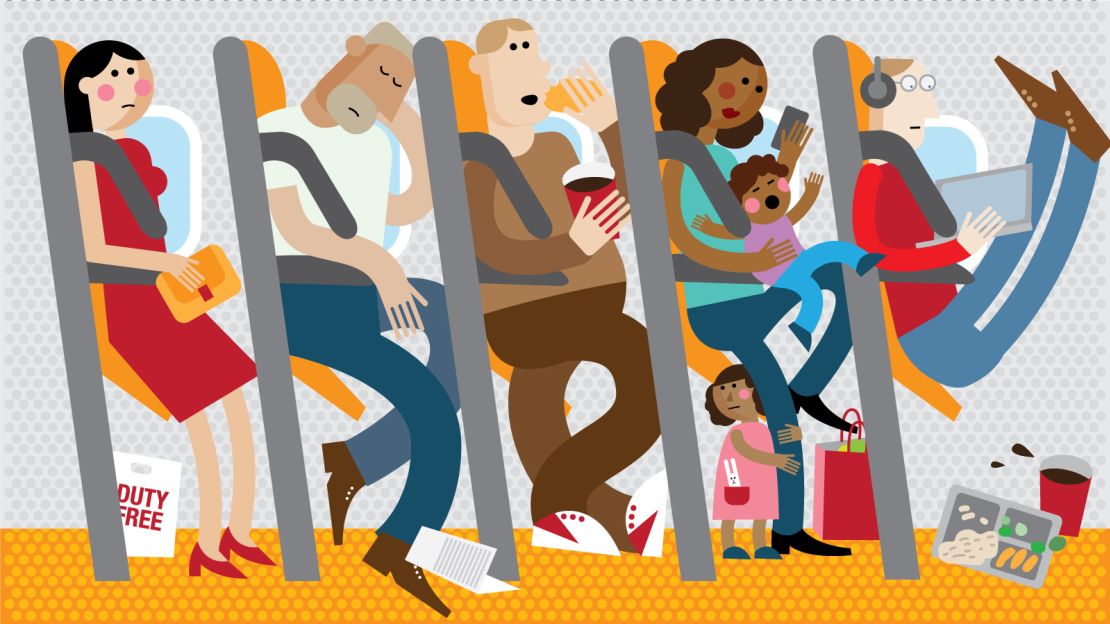You know that blissful feeling when you finally sit back in your airplane seat, giddy with the anticipation of being served delectable dishes on your way to an exotic destination?
Us neither.
And with airlines under pressure to slash fares and cram in ever more people without extending cabin space, passengers might soon be stacked on top of each other – literally.
Airbus has offered a chilling glimpse into what the future of air travel might hold with a patent that envisages two rows of seats layered on top of each other.
The patent states that the design “still provides a high level of comfort for the passengers” and seats could be reclined 180 degrees.
“There are myriad concerns when looking at this design, chiefly whether or not passengers would be able to evacuate in 90 seconds,” says Mary Kirby, editor of Runway Girl Network aviation news website.
The time frame is a regulatory requirement set out by the U.S. Federal Aviation Administration.
Kirby adds that the concept also doesn’t take passengers with disability into consideration, or pregnant women who might struggle to climb to the top level.
Around the world on budget airlines? Yes you can!
Midflight squat
But at least with this design passengers will actually be sitting down.
Not so much with the so-called saddle seat, another Airbus patent, which would require them to assume a semi-squat position during a flight.
The seat, which wouldn’t look out of place on a bicycle, has no headrest, with back support also limited.
The designers are under no illusion that this would make for a pleasant traveling experience.
The patent states that the increase in the number of seats is achieved to the detriment of the comfort of the passengers, but does offer these words of solace: “This remains tolerable for the passengers inasmuch as the flight lasts only one or a few hours.”
However, it’s still a notch up from the fully standing spaces proposed by Ryanair boss Michael O’Leary a few years ago.
The budget airline’s CEO took the no-frills concept to another level by suggesting passengers could be transported to their destination strapped in to a standing position for between $6 and $13.
Ryanair seems to have abandoned the idea for now.
“We have no plans to trial or introduce standing flights,” a spokesperson tells CNN.

Eye to eye
Those for whom flying means getting lost in a book or film while politely ignoring their neighbors probably won’t enjoy the designs from Zodiac Seats France.
Its Economy Class Cabin Hexagon consists of a tightly packed jigsaw of alternating backward and forward seats, making it difficult to maintain the number one rule of traveling on any form of public transport – avoiding eye contact.
Not to be outdone, Boeing has filed its share of eccentric patents, such as their “upright sleep support system.”
Its purpose is to help passengers rest during a flight by letting them lean face-forward into a cushion that has a hole to accommodate eyes, nose and mouth.
Another cushion supports the chest and both are deployed from a backpack attached to the seat.
Passengers may, however, run the risk of looking like they’ve overindulged in inflight alcohol.
Plane spotting: How a beginner can ID commercial jets
All in your head?
If the grim reality of air travel is too much to handle, why not escape your surroundings with the help of a sensory helmet?
The Airbus-patented headwear could isolate passengers from sound, sight, smell – or all three at once – for a more pleasant and relaxing journey.
Presumably this would come in handy if the person in front has lowered the back of their seat and the baby next to you has just had an accident.
The science fiction-like helmet would fit in with the company’s vision for the airplane of the future, which might look like a donut if Airbus has its way.
The patent for its futuristic-shaped aircraft looks like the plane is hoisting the popular pastry on its back, complete with a hole in the middle.
According to Airbus, this configuration can fit more passengers and distribute cabin pressure more evenly.

(Un)real prospects
Fliers can breathe a sigh of relief when it comes to some of the more outlandish patents – they’ll likely never see the light of day.
Airbus says that its latest stacked seats design is just one of several hundred they publish each year.
“We do this to protect our ideas, but many of these never actually develop beyond concept stages,” says Robert Gage, head of media relations for Airbus in the United Kingdom.
“This is all part of intellectual property strategy at play – the seat and aircraft makers are trying to cover themselves for the future, which is unknown, and the regulations of the future which are also unknown,” says Mary Kirby.
However, Kirby says that airlines’ trend toward stripping their service to the bone is pushing the boundaries of what travelers will accept.
“Passengers are really starting to get more vocal,” she says. “You do wonder when we will reach the tipping point and it gets so uncomfortable that there’s going to be serious backlash.”
Airline pricing secrets: How carriers come up with those wildly varying fares








